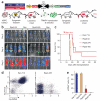Toolkit for evaluating genes required for proliferation and survival using tetracycline-regulated RNAi
- PMID: 21131983
- PMCID: PMC3394154
- DOI: 10.1038/nbt.1720
Toolkit for evaluating genes required for proliferation and survival using tetracycline-regulated RNAi
Abstract
Short hairpin RNAs (shRNAs) are versatile tools for analyzing loss-of-function phenotypes in vitro and in vivo. However, their use for studying genes involved in proliferation and survival, which are potential therapeutic targets in cancer and other diseases, is confounded by the strong selective advantage of cells in which shRNA expression is inefficient. We therefore developed a toolkit that combines Tet-regulated miR30-shRNA technology, robust transactivator expression and two fluorescent reporters to track and isolate cells with potent target knockdown. We demonstrated that this system improves the study of essential genes and was sufficiently robust to eradicate aggressive cancer in mice by suppressing a single gene. Further, we applied this system for in vivo negative-selection screening with pooled shRNAs and propose a streamlined, inexpensive workflow that will facilitate the use of RNA interference (RNAi) for the identification and evaluation of essential therapeutic targets.
Figures




Similar articles
-
Variability of inducible expression across the hematopoietic system of tetracycline transactivator transgenic mice.PLoS One. 2013;8(1):e54009. doi: 10.1371/journal.pone.0054009. Epub 2013 Jan 11. PLoS One. 2013. PMID: 23326559 Free PMC article.
-
Inducible shRNA expression for application in a prostate cancer mouse model.Nucleic Acids Res. 2003 Nov 1;31(21):e127. doi: 10.1093/nar/gng127. Nucleic Acids Res. 2003. PMID: 14576327 Free PMC article.
-
Tetracycline-inducible shRNA targeting antisense long non-coding RNA HIF1A-AS2 represses the malignant phenotypes of bladder cancer.Cancer Lett. 2016 Jun 28;376(1):155-64. doi: 10.1016/j.canlet.2016.03.037. Epub 2016 Mar 24. Cancer Lett. 2016. PMID: 27018306
-
RNA interference: from gene silencing to gene-specific therapeutics.Pharmacol Ther. 2005 Aug;107(2):222-39. doi: 10.1016/j.pharmthera.2005.03.004. Pharmacol Ther. 2005. PMID: 15908010 Free PMC article. Review.
-
Expression strategies for short hairpin RNA interference triggers.Hum Gene Ther. 2008 Apr;19(4):313-7. doi: 10.1089/hum.2008.026. Hum Gene Ther. 2008. PMID: 18363506 Free PMC article. Review.
Cited by
-
In vivo RNAi screens: concepts and applications.Trends Immunol. 2015 May;36(5):315-22. doi: 10.1016/j.it.2015.03.007. Epub 2015 Apr 27. Trends Immunol. 2015. PMID: 25937561 Free PMC article. Review.
-
Tightly regulated 'all-in-one' lentiviral vectors for protection of human hematopoietic cells from anticancer chemotherapy.Gene Ther. 2015 Nov;22(11):883-92. doi: 10.1038/gt.2015.61. Epub 2015 Jun 30. Gene Ther. 2015. PMID: 26125609
-
The EMT regulator ZEB2 is a novel dependency of human and murine acute myeloid leukemia.Blood. 2017 Jan 26;129(4):497-508. doi: 10.1182/blood-2016-05-714493. Epub 2016 Oct 18. Blood. 2017. PMID: 27756750 Free PMC article.
-
Inducible and reversible lentiviral and Recombination Mediated Cassette Exchange (RMCE) systems for controlling gene expression.PLoS One. 2015 Mar 13;10(3):e0116373. doi: 10.1371/journal.pone.0116373. eCollection 2015. PLoS One. 2015. PMID: 25768837 Free PMC article.
-
Sensitivity and engineered resistance of myeloid leukemia cells to BRD9 inhibition.Nat Chem Biol. 2016 Sep;12(9):672-9. doi: 10.1038/nchembio.2115. Epub 2016 Jul 4. Nat Chem Biol. 2016. PMID: 27376689 Free PMC article.
References
-
- Huesken D, et al. Design of a genome-wide siRNA library using an artificial neural network. Nat. Biotechnol. 2005;23:995–1001. - PubMed
-
- McCurrach ME, Lowe SW. Methods for studying pro- and antiapoptotic genes in nonimmortal cells. Methods Cell Biol. 2001;66:197–227. - PubMed
-
- Schmitt CA, et al. Dissecting p53 tumor suppressor functions in vivo. Cancer Cell. 2002;1:289–298. - PubMed
Publication types
MeSH terms
Substances
Grants and funding
LinkOut - more resources
Full Text Sources
Other Literature Sources
Research Materials

